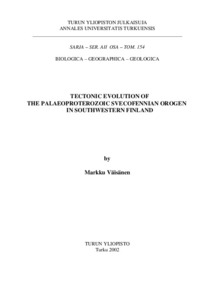Tectonic Evolution of the Palaeproterozoic Svecofennian Orogen in southwestern Finland.
Markku Väisänen
https://urn.fi/URN:NBN:fi-fe2021042714892
Tiivistelmä
The tectonic evolution of the Svecofennian Orogen in southwestern Finland can be divided into pre-collisional, collisional and post-collisional stages. The pre-collisional stage includes the formation of the Southern Svecofennian Arc Complex, rifting of the arc complex and filling of the basin(s) with mafic and ultramafic lavas and erosional sediments. In the Orijärvi area, the oldest arc type volcanic rock was dated at 1895 Ma from the bimodal Orijärvi formation and the youngest at 1878 Ma from the mature Kisko formation. The Orijärvi granodiorite was dated at 1898 Ma which together with the similar geochemistry to the felsic volcanic rocks, implies that it is a synvolcanic intrusion. SIMS ages on detrital zircons in sedimentary rocks yield ages between 2.9-1.97 Ga suggesting that the erosional detritus was derived from outside the Southern Svecofennian Arc Complex.
The U-Pb ages of the synorogenic intrusions, now verified by the ion microprobe SIMS dating, indicate that collision of the Southern Svecofennian Arc Complex with the Central Svecofennian Arc Complex took place at 1.88-1.86 Ga. Zircon populations in synorogenic intrusions also included inherited older Palaeoproterozoic and Archaean zircons. Deformation related to the main collision is expressed by a D1/D2 deformation recorded as a bedding-parallel S1 mica foliation deformed into tight to isoclinal D2 folds with subhorizontal axial planes and a penetrative S2 axial plane foliation. The syntectonic tonalites were emplaced during D2 as sheet intrusions. In the Turku migmatite complex garnet and cordierite of the first generation are mostly breakdown products of biotite and sillimanite and their growth is mainly syntectonic with D2 as they are elongated within the S2 plane and deformed by D3 folds.
The post-collisional convergence transposed previous structures into NE-SW or E-W trending upright or NW overturned D3 folds. Granitic veins and dykes were intruded along S3 axial planes. Large D3 fold limbs are often strongly deformed, intensely migmatized and intruded by garnet- and cordierite-bearing granites. These observations suggest that the potassium-rich leucosomes, now dated at 1824 Ma, provide the age of D3 deformation. Crustal anatexis continued until ca. 1810 Ma. Pressure and temperature estimates from garnet and cordierite indicate that the granulites reached temperatures in excess of 800 °C at approximately 6 kbar pressure while the adjacent amphibolite facies rocks crystallized at 100-150 °C and 1-2 kbar lower temperatures and pressures. Zircons in enderbites display synorogenic core ages of ca. 1.88-1.87 Ga and metamorphic overgrowths at ca. 1.83-1.80 Ga. It is suggested here that mafic mantle derived magmatism provided heat for granulite facies metamorphism. Mafic rocks are shoshonitic monzodiorites that triggered anatexis and formation of S-type anatectic granites, both dated at 1815 Ma. The geochemical characteristics of the mafic rocks suggest that they were derived from the subcontinental lithospheric mantle, that was previously enriched by fluids released during earlier subduction. It is suggested here that the hot upwelling asthenosphere convectively removed the subcontinental lithospheric mantle and raised the temperature. This triggered partial melting of the enriched parts of the mantle. Uprising mafic melts increased the already high temperatures at mid-crustal levels and caused granulite facies metamorphism, crustal anatexis and production of granitic melts.
The zircon ages of the volcanic and plutonic rocks indicate that pre-collisional and collisional stages of crustal evolution are ca. 10 Ma younger in the Southern Svecofennian Arc Complex than in the Central Svecofennian Arc Complex. Therefore, the evolution of the Svecofennian orogeny is diachronous with younging of successive orogenic events from the Archaean craton towards the southwest.
Kokoelmat
- Rinnakkaistallenteet [19204]
